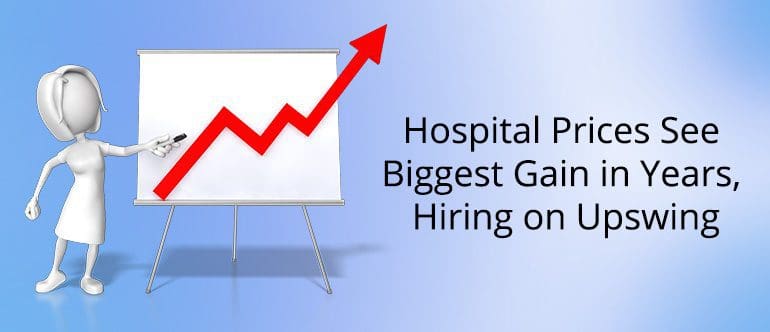Call us toll-free: 800-878-7828 — Monday - Friday — 8AM - 5PM EST


By Les Masterson for Healthcare Dive
Brief:
- Healthcare prices grew 2.2% in February 2018 compared to the previous February. That was the highest rate increase since January 2012, according to Altarum’s latest Health Sector Economic Indicators. Year-over-year hospital prices increased even higher at 3.8%, the highest monthly increase since November 2009.
- Looking back at 2017, national healthcare spending grew by 4.6% for the year compared to the previous year. Altarum said healthcare spending’s share of GDP has been between 17.9% and 18.1% for 22 consecutive months.
- Hospitals are on a hiring spree, adding 9,300 jobs in February compared to the 7,200 monthly average in 2017.
Insight:
February’s 2.2% healthcare price growth is compared to 1.6% full-year growth in 2016 and 2017 and the all-time lowest rate of 1.1% in 2015. Annual hospital price growth rose sharply to 3.8% — its highest pace since November 2009.
Altarum Fellow Dr. Charles Roehrig noted that differs from the trend seen in government data. “We are puzzling over this significant jump in hospital prices in recent months based upon the hospital (producer) price indexes from Bureau of Labor Statistics. Hospital prices averaged 1.6% growth in 2017, increasing to 3.5% during the first 2 months of 2018. Further, growth has accelerated for each of the three main payers: Medicare, Medicaid, and private health plans.”
One major reason for the overall spending increase is prescription drug spending,which grew 5% in 2017 after increasing by only 1.3% the previous year.
“This 5.0 growth estimate does not account for possible changes in prescription drug rebates and, based upon 2016, we expect this could lead to a significant downward revision in the growth rate when CMS releases official 2017 estimates this December,” Altarum said.
The report is the latest to highlight rising healthcare costs. A recent JAMA report found the U.S. is spending about twice as much as other high-income countries on medical care. That’s despite similar utilization rates. Driving the difference is labor and goods, including pharmaceuticals and administrative costs.
In one piece of good news — hospital hiring is on an upswing. The first two months of 2018 saw modest job growth, Altarum said. Healthcare overall added 18,500 jobs in February, which was fewer than the the 2017 monthly average of 24,000. However, about half of the job growth came from hospitals, despite those facilities accounting for just one-third of health sector jobs.
The uptick in hospital hiring could be connected to the stalled Republican effort to repeal and replace the Affordable Care Act. With that policy debate largely over, hospitals now feel comfortable to resume hiring levels because they aren’t expecting major policy changes anytime soon.
While hospitals’ hiring increased, ambulatory setting jobs have slowed from last year. Ambulatory settings added 8,100 new jobs in February compared to a monthly average of 15,500 in 2017.
Also, in healthcare jobs news, the American College of Physicians recently reported that internal medicine is the largest training specialty. One-quarter of all PGY-1 positions in the 2018 Main Residency Match were in internal medicine. Internal medicine programs offered 7,542 categorical positions and 374 primary care positions, an increase of 309 categorical positions (4.3%) and 33 primary care positions (9.7%) from the 2017 Match, the American College of Physicians said.
